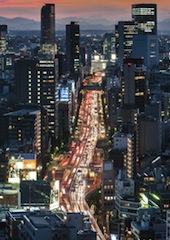Going Backwards in Japan
Say goodbye to a system that was equitable and among the fairest in the world.
October 31, 2013

When I came to Japan 35 years ago, this country seemed the most equitable and egalitarian place in the world. Unemployment was negligible and illiteracy was non-existent. Everybody was entitled to, and had, health insurance. The gap between the rich and poor was not so big — and most people believed they were happy with their lives.
The highest-paid person in a company, such as the president or chairman, received no more than 10-12 times the salary of the lowest paid employee. Most Japanese therefore felt satisfied with their lives. Not anymore.
Over the last two decades, Japanese employers have reshaped the employment landscape by making every third employee “non-regular.” (This trend is, arguably, a special “gift” from the United States, via consulting firms such as McKinsey and other cost-cutting HR specialists.) These “non-regular” employees include contract, part-time seasonal workers and day laborers.
This new category of workers does not receive any benefits such as medical, pension, paid leave and social security, to which “regular” employees in most sectors of the economy are entitled. Nor is there a guarantee of continuing employment.
A contingent workforce as a country’s backbone?
According to data released recently by the Japanese Internal Affairs and Communications Ministry, the number of Japanese working on non-regular or part-time basis reached 38.2% of the workforce. Expressed another way, the number of Japanese who do not have regular employment surpassed 20 million in 2012.
Furthermore, the average annual wages of non-regular workers is only 1.6 million yen (about $16,400 or €11,900), compared to 4.6 million yen ($47,000 or €34,200) earned by regular employees. In other words, the non-regular workers make only one-third of what the regular employees earn.
The difference of 3 million yen in average annual earnings translates across the economy to 60 trillion yen, the amount by which 20 million non-regular workers are being short-changed annually. Say goodbye to a system that was equitable and among the fairest in the world!
Say goodbye, also, to a society that has been cohesive, caring and at peace with itself. These 20 million people are seeing a Japan that is different from what their parents saw, and they feel cheated.
Demographic consequences
They are delaying getting into relationships, postponing getting married if at all, and not having children. According to figures from a survey conducted by the Cabinet Office, the population of Japan fell 0.22% compared to last year. This represents a decrease of 284,000 in its population so far this year.
It has been estimated that the population of Japan will continue to shrink, and by 2060 it will be 80 million (down from about 126 million now).
It had been previously explained that the shift away from regular employment was mostly due to the individual attitudes of young people, raised in affluence during the boom years before the bursting of the economic bubble.
These people were called “freeters” — and it wasn’t necessarily a derogatory term. Rather, being a “freeter” almost seemed fashionable or the ‘in’ thing to do during the mid-1990s.
Only later, as this trend exploded and started to affect employees of all ages, and across all categories, did it become clear that the shift towards non-regular workers was universal. It had been fueled by employers trying to reduce personnel costs — rather than the beginning of a new social trend.
Consumption problems
Mr. Abe’s “Three Arrows” are pointed at various things. However, the regular/non-regular (workers) divide is not among the targets. Paul Krugman once said, with good reason, that the problem which plagues the Japanese economy is the problem of consumption.
I don’t see how you can increase domestic consumption if you have yourself created a class of workers, 20 million strong, who earn two-thirds less than the regulars, who have no entitlements or benefits — and who live mostly hand to mouth.
The second half of the 20th century was remarkable in that most countries of the developed world were motivated, and able to create, societies that are caring and equitable. They were driven by a genuine concern for happiness and human welfare.
It is unfortunate that, during its two lost decades, Japan began to move in the opposite direction by diluting the meaning of a “Just Society.” And we must worry about one more thing – that, rather than being the outlier, it is showing other major nations the way “forward.”
Social developments in the United States are such that it increasingly exhibits traits of the Japanese disease with bifurcating society into a regular and a largely contingent workforce. Statistically, the two countries aren’t far apart any longer, especially considering that social benefits in the United States were never that generous to begin with.
And post-crisis Europe, in turn, is also exhibiting ever more elements of the Japanese-American disease.
Takeaways
35 years ago, Japan seemed the most equitable and egalitarian place in the world.
In Japan, almost 40% of the workforce is now a '”non-regular employee.
What was hailed as a new social trend and lifestyle choice was fueled by firms trying to reduce personnel costs.
The US increasingly exhibits traits of the Japanese disease with bifurcating society into two workforces.

